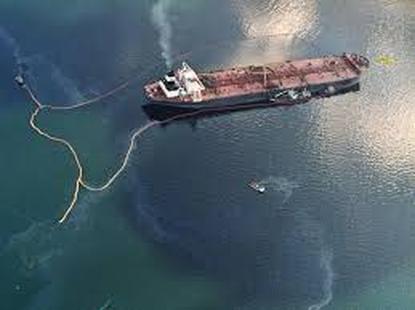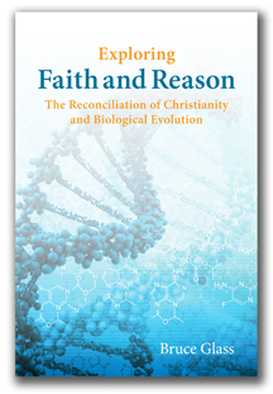Creation Care from the Perspective of a Conservation Geneticist
 Dark, oil-saturated waters
by Eric Kretschmer
I love God and I enjoy science. When I was younger, I did not realize that growing up as a Christian with a passion for both would lead to rigorous discussions and debates about whether I could only be a scientist or a theologian. I was often told by both sides of the science/theology conversation that if I was to intellectually commit to one field, I would b need to set the other field aside. I have found quite the opposite to be the case, having earned a B.S. Degree in Genetics from UC Davis and an M.A. in Theology from Bethel Theological Seminary. When discussing the relationship between science and theology, one of the questions that naturally occurs is the question of how God and his people interact with creation. Having worked for close to fifteen years in the field of conservation genetics, and then pursuing a graduate degree in Theology, I have gained some perspectives related to our stewardship of the earth, an area of study often referred to as “creation care.” This topic cuts in two directions: First, it requires us to ask what value we place on humanity and, second, what value we place on the natural world? I think a major task for Christians who have been raised in the fundamental evangelical protestant tradition (like myself) is to better understand how we are part of a unified whole within nature as permanent and dependent residents of planet earth. I have seen first-hand the need for humans to place more value on all of life and to carefully assess how we might adversely affect our environment to the detriment of our fellow creatures. I worked in the field of genetics for the Alaska Department of Fish and Game (ADF&G) and the US Fish and Wildlife Service (USFWS) in Anchorage, Alaska from 1995-2009. When I was hired by the State of Alaska in 1995, the position was initially funded by money awarded to the State of Alaska to help ameliorate the Exxon Valdez Oil Spill (EVOS). So my initial work in the field of conservation genetics was a direct result of an environmental disaster. According to the U.S. Environmental Protection Agency: On March 24, 1989, shortly after midnight, the oil tanker Exxon Valdez struck Bligh Reef in Prince William Sound, Alaska, spilling more than 11 million gallons of crude oil…the spill posed threats to the delicate food chain that supports Prince William Sound's commercial fishing industry. Also in danger were ten million migratory shore birds and waterfowl, hundreds of sea otters, dozens of other species, such as harbor porpoises and sea lions, and several varieties of whales.[1] My specific work for the state ranged from detecting genetic damage caused by pollution (such as the EVOS), to monitoring species that were in danger of being harvested by other countries (such as walleyed pollock in the Bering Sea), to monitoring the overfishing of crab stocks in Prince William Sound. Historically, the overharvesting of fish stocks in the Lower Forty-Eight (a term Alaskans use to describe the Continental United States) has caused crashes in salmonid populations all along the west coast, from southern California to the state of Washington. In an attempt to avoid repeating this historical misuse of natural resources, the state of Alaska has developed rigid guidelines for regulating fishing and hunting. By developing “genetic fingerprints” of Alaska’s wild stocks of fish populations, the state now has a powerful tool for helping regulate and monitor its fisheries. One project I was personally involved with during my time at the USFWS was to help determine the run timing for salmon entering the Yukon River. The Yukon River is not only an Alaskan (and by default US) river; it also crosses into Canada. People living all along the Yukon in the US and Canada are dependent on the salmon runs for their subsistence lifestyle, and the commercial fishing industry in the US also profits from these yearly runs. So how can we make sure enough salmon are returning and spawning to keep up healthy numbers for future runs, allow those dependent on this fishery to catch what they need to survive off the land, and help guarantee that the Canadians are getting their salmon, too? To help solve this problem, biologists took data collected over several years from salmon spawning in all of the streams, creeks, and rivers that feed into the Yukon River, from its headwaters in Canada to the delta where it enters the Bering Sea. Geneticists then developed unique genetic fingerprints for each population. By developing these fingerprints, geneticists can then monitor trends in the allelic frequencies of these populations, to help us determine if there is negative pressure from over-fishing at certain times of the year, or perhaps a sex-bias in the populations due to net mesh sizes, etc. Geneticists can also use these fingerprints to differentiate between salmon that return to the US side of the Yukon verses those who return to the Canadian portion of the Yukon. This genetic tool has also allowed those managing this fishery to better estimate run timing, sampling salmon “in season” once they enter the Yukon River, allowing Canadian salmon to pass through the US waters, and so maintain not only Canada’s natural resource, but healthy salmon stocks for all who depend on this natural resource. This is just one example of how conservation genetics can be utilized in the pursuit of preserving our natural resources. As a Christian in this line of work, I saw a clear parallel between caring for the state’s natural resources and God’s charge to humanity to care for his creation. In fact, I find it interesting that both the government and the field of theology refer to creation care in terms of “mandates”. Christians who study science and embrace modern biology can make a profound impact on the care of creation in ways that Christians who don’t study these things cannot. This is one reason that, aside from my full-time job as a pastor, I teach Biology and AP Biology at a local Christian school here in Alaska. I am convinced that we need to encourage young Christians towards engaging more seriously in the sciences, teaching them to do good science while helping them grow in their faith. There is a bias against scientists within many Christian communities that concerns me because this attitude can discourage young people from going into science at all. Along with educating young Christians in science, we also need to train them to handle biblical scripture well. I think it is unfortunate that so many religious people tend to elevate humanity so far above the animal kingdom that they treat our fellow creatures with a certain level of contempt, exploiting them to the point of extinction. Many theologians blame this attitude on a misunderstanding and misapplication of God’s original intent when he gave us the Divine Mandate in Genesis 1:28 to, “subdue and have dominion over every living thing on the earth.” This command must be understood in light of Genesis 2:15, when the work we were originally given was to maintain and care for the Garden. The Hebrew word for “care” in Genesis 2:15 can also be interpreted as “preserve,” “keep,” or “guard.” This is precisely the work I was involved in as a conservation geneticist. I realize that many atheists have the opposite perspective, holding humanity in contempt of nature (like the idea that humans are a ‘virus’ or a problem that needs to be controlled or eradicated). I personally believe that Christians should be involved at the forefront of any discussions related to the conservation of our natural world, being careful to communicate an accurate biblical worldview that speaks both to the special role humans have in caring for God’s creation as well as God’s love for his world and the people who bear his image. [1] “Exxon Valdez”, http://www.epa.gov/osweroe1/content/learning/exxon.htm. |






